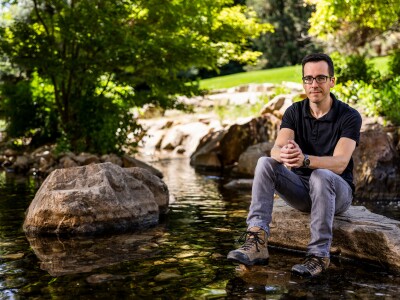Brigham Young University microbiology majors Kathryn Distelhorst and Elizabeth Nielsen Low are co-authors alongside scientists from the Harvard and Stanford medical schools on a research paper that made an important discovery about how breastfeeding protects babies from infection.
The two years they each have spent in the lab of Eric Wilson, BYU assistant professor of microbiology and lead author on the paper, have paid off with a publication in a prestigious journal, the Journal of Immunology, before they have even graduated.
"It was really neat to see my research actually get published," said Distelhorst, who performed microscopic observations for the study. "It was a good motivation and a bit of added pressure to know it would get published."
Low, who conducted scientific tests to further verify the study's findings, said that her research experience enhanced her classroom learning.
"In a few of my classes we'll talk about someone making a big discovery in history, and I'll have used the same technique myself in the lab," she said. "I'll be like 'Oh, I've done that before.'"
The pair's lab work contributed to the study's major finding: the identification of a molecule vital to a mother's ability to pass on immunity to her baby.
The study highlights an amazing change that takes place in a mother's body when she begins producing breast milk. For years before her pregnancy, cells that produce antibodies against intestinal infections travel around her circulatory system as if it were a highway and regularly take an "off-ramp" to her intestine. There they stand ready to defend against cholera or rotavirus and other invaders. But once she begins lactating, some of these same antibody-producing cells suddenly begin taking a different "off-ramp," so to speak, that leads to the mammary glands. That way, when her baby nurses, the antibodies go straight to the baby's intestine and offer protection while baby builds up its own immunity.
This is crucial because severe diarrhea caused by intestinal infections can be fatal to infants. It is also why previous studies have shown that formula-fed infants have twice the incidence of diarrheal illness as breastfed infants.
Until now, scientists did not know how the mother's body signaled the antibody-producing cells to take the different off-ramp. The new study identified the molecule that gives them the green light.
"Everybody hears that breastfeeding is good for the baby," said Wilson. "But why is it good? One of the reasons is that mothers' milk carries protective antibodies which shield the newborn from infection, and this study demonstrates the molecular mechanisms used by the mother's body to get these antibody-producing cells where they need to be."
Understanding the role of the molecule, called CCR10, also has implications for potential future efforts to help mothers better protect their infants.
"This tells us that this molecule is extremely important, so if we want to design a vaccine for the mother, so she could effectively pass protective antibodies to the child, it would be absolutely essential to induce high levels of CCR10," said Wilson.
Daniel Campbell is a researcher at the Benroya Research Institute in Seattle, a nonprofit organization that specializes in the immune system, and was not affiliated with this study.
"The molecular basis for this redistribution [of the mother's cells] has not been well- characterized, but Dr. Wilson's work has begun to crack that code and define the molecules responsible for this cellular redistribution and passive immunity," Campbell said. "It is important work that fundamentally enhances our understanding of how immunity is provided to the [baby] via the milk. Dr. Wilson's study will certainly form the basis for many other studies aimed at uncovering how the immune system is organized, particularly at mucosal surfaces."
Speaking broadly about the long-term applications of her research, Low said, "If we know how these cells migrate, we'll be able to hit the right targets to get them to go where we want."
She said that participating in this study prepared her for her research internship at Harvard last summer.
"I've talked to friends at other universities and they don't get opportunities like we do [at BYU]," she said. "I thought I'd be way behind everyone at Harvard but when I got there I found I really knew my stuff. I totally attribute that to being in Dr. Wilson's lab."
She feels that publishing this paper, and the paper she plans to publish on the work she's doing now, will open doors.
"For graduate school, it's a huge leg up to have a publication," she said. "They see that not only did you have research experience, but they see that you did something with it."
Distelhorst, who did a research internship of her own at Washington University at Saint Louis, feels gratified by the contribution her study makes to an important aspect of human health.
"Your immune system is a vital part of your body," she said. "When we understand how it's regulated, we can better understand what we need to do to enhance our immune response."
In addition to federal funding from the National Institutes of Health, Wilson's lab received a Mentoring Environment Grant from BYU and Low and Distelhorst each earned BYU ORCA grants that support undergraduate research.
Writer: Brady Toone







